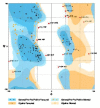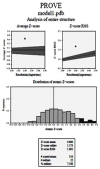Structural Prediction and Mutational Analysis of Rv3906c Gene of Mycobacterium tuberculosis H37Rv to Determine Its Essentiality in Survival
- PMID: 30186322
- PMCID: PMC6114228
- DOI: 10.1155/2018/6152014
Structural Prediction and Mutational Analysis of Rv3906c Gene of Mycobacterium tuberculosis H37Rv to Determine Its Essentiality in Survival
Abstract
The emergence of tuberculosis is at the peak; therefore to station it at its lower level we hereby try bioinformatics approach against Mycobacterium tuberculosis [M. tuberculosis] pathogenesis. Rv3906c is a conserved hypothetical gene of M. tuberculosis and contains many GTP binding protein motif DXXG which demonstrate that this gene might be processed in a GTP binding or in GTP hydrolyzing manner. This gene shows interaction with its adjacent genes as well as pcnA which is a polymerase and localized in the extracellular region and found to be a soluble protein. Rv3906c has binding pockets for calcium atom at various positions which prove that calcium might have some role during the process of this gene. GTP binding protein motif DXXG is present in various positions and calcium binds at this site with a C-score of 0.25. Mutational analysis on this motif shows the large decrease of stability after mutation of aspartate residue with glycine. Stress conditions like pH and temperature also change stability of the protein. A decrease in stability at this position might play a role in inhibition of survival of the pathogen. These computational studies of this gene might be a successful step towards drug development against tuberculosis.
Figures











Similar articles
-
Essential biochemical, biophysical and computational inputs on efficient functioning of Mycobacterium tuberculosis H37Rv FtsY.Int J Biol Macromol. 2021 Feb 28;171:59-73. doi: 10.1016/j.ijbiomac.2020.12.182. Epub 2021 Jan 5. Int J Biol Macromol. 2021. PMID: 33412199
-
Comprehensive analysis of GTP cyclohydrolase I activity in Mycobacterium tuberculosis H37 Rv via in silico studies.Biotechnol Appl Biochem. 2021 Aug;68(4):756-768. doi: 10.1002/bab.1988. Epub 2020 Aug 8. Biotechnol Appl Biochem. 2021. PMID: 32691412
-
Elucidating the structural and functional prophecy of the Rv2326c gene, an ABC transporter of Mycobacterium tuberculosis H37Rv through computational approach.Biotechnol Appl Biochem. 2023 Dec;70(6):2025-2037. doi: 10.1002/bab.2507. Epub 2023 Aug 22. Biotechnol Appl Biochem. 2023. PMID: 37606005
-
Domain-wise differentiation of Mycobacterium tuberculosis H37 Rv hypothetical proteins: A roadmap to discover bacterial survival potentials.Biotechnol Appl Biochem. 2022 Feb;69(1):296-312. doi: 10.1002/bab.2109. Epub 2021 Feb 2. Biotechnol Appl Biochem. 2022. PMID: 33469971
-
Survival mechanisms of pathogenic Mycobacterium tuberculosis H37Rv.FEBS J. 2010 Jun;277(11):2416-27. doi: 10.1111/j.1742-4658.2010.07666.x. FEBS J. 2010. PMID: 20553485 Review.
Cited by
-
Computational evaluation of anticipated PE_PGRS39 protein involvement in host-pathogen interplay and its integration into vaccine development.3 Biotech. 2021 Apr;11(4):204. doi: 10.1007/s13205-021-02746-3. Epub 2021 Apr 1. 3 Biotech. 2021. PMID: 33824847 Free PMC article.
-
Increases in Hydrophilicity and Charge on the Polar Face of Alyteserin 1c Helix Change its Selectivity towards Gram-Positive Bacteria.Antibiotics (Basel). 2019 Nov 27;8(4):238. doi: 10.3390/antibiotics8040238. Antibiotics (Basel). 2019. PMID: 31783657 Free PMC article.
-
Mechanistic Insight into the Enzymatic Inhibition of β-Amyrin against Mycobacterial Rv1636: In Silico and In Vitro Approaches.Biology (Basel). 2022 Aug 12;11(8):1214. doi: 10.3390/biology11081214. Biology (Basel). 2022. PMID: 36009841 Free PMC article.
-
Fludarabine, a Potential DNA-Dependent RNA Polymerase Inhibitor, as a Prospective Drug against Monkeypox Virus: A Computational Approach.Pharmaceuticals (Basel). 2022 Sep 9;15(9):1129. doi: 10.3390/ph15091129. Pharmaceuticals (Basel). 2022. PMID: 36145351 Free PMC article.
-
Kanamycin-Mediated Conformational Dynamics of Escherichia coli Outer Membrane Protein TolC.Front Mol Biosci. 2021 Apr 15;8:636286. doi: 10.3389/fmolb.2021.636286. eCollection 2021. Front Mol Biosci. 2021. PMID: 33937327 Free PMC article.
References
-
- World Health Organization. Global Tuberculosis Report 2015, WHO, 2016.
LinkOut - more resources
Full Text Sources
Other Literature Sources
Research Materials
Miscellaneous
